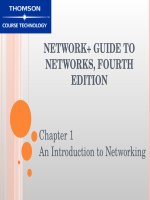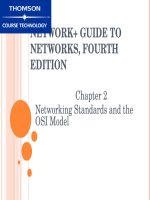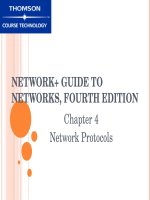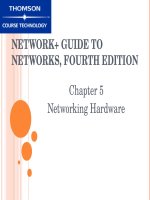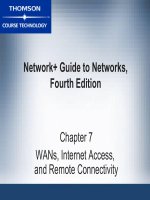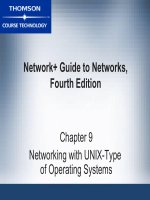Guide to network essentials 4th chapter 08
Bạn đang xem bản rút gọn của tài liệu. Xem và tải ngay bản đầy đủ của tài liệu tại đây (449.54 KB, 50 trang )
Chapter 8:
Simple Network
Operations
Learning Objectives
Explain the operation fundamentals of network
operating systems
Understand the various networking software
components
Describe the basic steps required for network
operating system installation
Define network services
Understand network application installation and
configuration concepts
Guide to Networking Essentials, Fourth
2
Network Operating Systems
Network operating systems
Initially,
merely communications software packages or
additions to standalone operating systems
Example: Microsoft LAN Manager
Later, true network operating systems handled
network communications and operations of
standalone computer
Examples: Novell NetWare, Windows NT Server,
Windows 2000 Server, Windows 2003 Server,
UNIX, and Linux
Guide to Networking Essentials, Fourth
3
NOS Demands
Multitasking – able to support numerous
processes simultaneously
True
multitasking requires as many CPUs as
simultaneous processes (multiprocessing)
Time slicing simulates multitasking
Two types of multitasking
Preemptive
multitasking – OS controls what process
gets access to CPU and for how long
Cooperative multitasking – relies on process itself to
relinquish control of CPU
Guide to Networking Essentials, Fourth
4
Software Components of Networking
True NOS manages activities of local computer and
enables communication over network media
Connects
all machines and peripherals; coordinates
and controls functions of machines and peripherals
Supports security and privacy; controls access to
resources on a user authentication basis
Advertises and manages resources from centralized
directory; gives ability to share resources such as
printers
Includes client and server network software
Guide to Networking Essentials, Fourth
5
General NOS Components
NOS includes many software components and
services:
Naming
Services
Directory Services
Client Network Software
Server Network Software
Guide to Networking Essentials, Fourth
6
Naming Services
Most networks require names to identify and
access resources on network
Naming
services translate symbolic names into
corresponding network addresses
For example www.course.com translates to
63.218.23.135 or on a local network the server
Accounting, may translate to 172.16.10.1
Guide to Networking Essentials, Fourth
7
More About NetBIOS Names
Prior to Windows 2000, Microsoft networking
used NetBIOS names
Rules of NetBIOS naming
No
longer than 15 characters
End name with dollar sign to hide the shared device
from the network
Guide to Networking Essentials, Fourth
8
Microsoft’s Universal Naming
Convention
Drive mapping associates network drive
resource with local drive letter
Another standard method uses Universal
Naming Convention (UNC) name
Form
is \\servername\sharename
UNC-aware applications may use UNC name rather
than drive letter
Guide to Networking Essentials, Fourth
9
Domain Names and DNS
Domain Name System (DNS) translates
domain names into numeric IP addresses
Allows
users to access resources by using
text-based domain name
Windows 2000 Server introduced Dynamic DNS
(DDNS)
Will
replace NetBIOS naming service in Microsoft
networks
Guide to Networking Essentials, Fourth
10
Directory Services
Allow users to look up things by name or by type
of service or resource (such as printers)
Two complete directory services that use “tree
and forest” metaphor to organize directory
content are:
Active
Directory introduced with Windows 2000
Novell Directory Services (NDS) introduced with
Novell NetWare version 4
Network Information System (NIS) used in Linux
May use add-on directory services for Linux
Guide to Networking Essentials, Fourth
11
Directory Services (continued)
Directory servers also store access control
Both Active Directory and NDS are built on
X.500
Lightweight Directory Access Protocol
(LDAP) has less overhead than X.500
Easier
to implement
Supports remote devices
Guide to Networking Essentials, Fourth
12
Client Network Software
Installed on user’s computer; requests resources
from server
Redirector is most important software component
Operates
on both client and server at Presentation
level
Intercepts user’s request, examines it, and
determines if request can be filled by local CPU
If not, redirector routes requests over network to
server or host of resource
Guide to Networking Essentials, Fourth
13
Client Network Software (continued)
Designator is another NOS software component
Aids
in interaction with network resource
Keeps track of drive letters assigned locally to remote
or shared drives
Substitutes real network address for mapped
drive letter
Both redirector and designator are important for
file and print sharing
Guide to Networking Essentials, Fourth
14
Server Network Software
Hands out resources and services to clients
Server components are more complex than
client components
Allows sharing of resources, as seen in
Figure 8-1
Restricts access to resources
Called
access controls
Provide data privacy and protection
Guide to Networking Essentials, Fourth
15
Server’s Functions
Guide to Networking Essentials, Fourth
16
Server Network Software (continued)
Other responsibilities of server NOS include:
Management
of users and groups
Resource advertisement, name services, and
directory services
Logon authentication of users
Management, control, and auditing tools to administer
network
Fault-tolerance to protect integrity of network and its
data
Guide to Networking Essentials, Fourth
17
Client and Server
Many NOSs include client and server
capabilities in Server and Professional
versions
Examples:
Windows 2000 and Windows XP
Linux uses same version to run workstations and
servers
Guide to Networking Essentials, Fourth
18
Installing a Network Operating System
Much like installing standalone operating system
Few
extra steps for configuration of network and
server services
Important to complete preparatory steps
before installing NOS
Guide to Networking Essentials, Fourth
19
Installation Preparation
Understand many aspects of network before
installing NOS, including:
Type
of network (topology)
Size of network
Job requirements of server
File system to be used
Identification or naming convention
Types of OSs on servers and clients
Organization of storage devices
Guide to Networking Essentials, Fourth
20
Job Requirements
Evaluate services that machine will do, including:
DNS
DHCP
Web
services
Remote access
In Windows networking, server may be:
Domain
controller – maintains directory and security
database
Member server – hosts services and resources
Guide to Networking Essentials, Fourth
21
Job Requirements (continued)
Some servers support fault tolerant features:
Disk
mirroring
Disk duplexing
Redundant Array of Inexpensive Disks (RAID)
Guide to Networking Essentials, Fourth
22
Naming Conventions
Good naming convention includes user accounts,
computers, directories, network shares, printers,
and servers
Names
should be descriptive
Conventions should be:
Consistent
across all objects
Easy to use and understand
Simple to construct new names
Clearly identify object types
Guide to Networking Essentials, Fourth
23
Storage Device Organization
Most important decision involves drive partitioning
Partition
is logical organization of disk space
Different schools of thought about organizing NOS
host drive:
Multiple-boot
Single-partition,
single-NOS
Multiple-partition, single-NOS
Fault-Tolerant Storage
Guide to Networking Essentials, Fourth
24
Storage Device Organization (continued)
File system is second important issue:
Some
high-performance file systems, such as NTFS,
provide object-level security
Others, such as FAT, are less secure, but offer
compatibility with other OSs
Guide to Networking Essentials, Fourth
25

